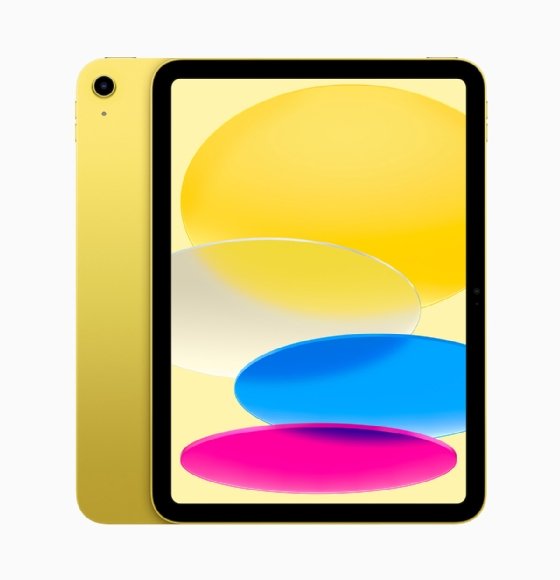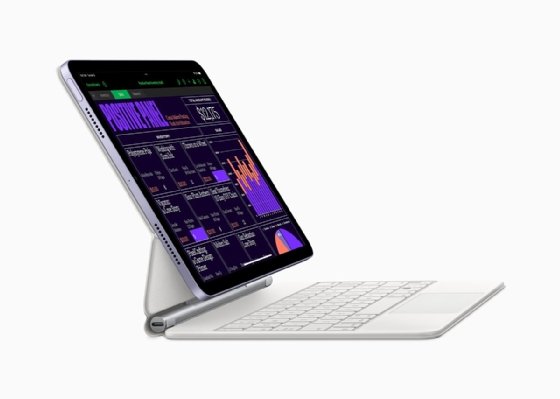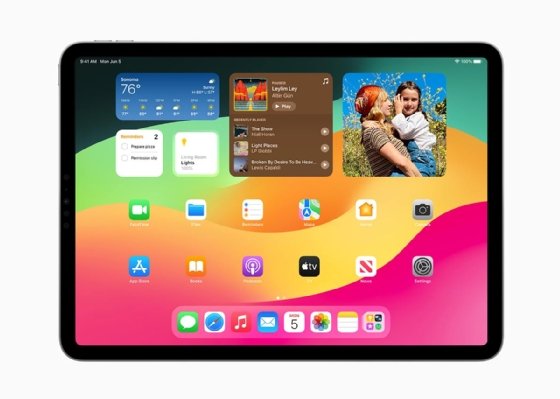iPad
What is an iPad?
The iPad is a touchscreen tablet PC made by Apple. The original iPad debuted in 2010. Apple has four iPad product lines: iPad, iPad mini, iPad Air and iPad Pro. All models are available in a variety of colors. They run Apple iPadOS mobile operating system (OS) and have Wi-Fi and Bluetooth connectivity. The latest models support 5G cellular service.
These portable devices provide a more substantial computer device than a smartphone; however, they don't come with all the features and capabilities of a laptop. They are easy to use and have Apple's highly optimized hardware and software that the company designs and updates.

How does an iPad work?
IPads include a central processing unit, memory, display, and back and front cameras. They run iPadOS, Apple's iOS version for the iPad; have a graphic touchscreen display; support cellular service; and have a microphone, speaker and connectors such as USB-C. Users power on the device, log in and launch the desired applications.
IPad apps can be downloaded from the Apple App Store. As with any mobile device, battery life is an important factor when using an iPad. The device's power management has steadily improved with each new generation.
Why is the iPad important?
Convenience and ease of use are two important attributes of the iPad. Like all tablets, iPads are light and mobile compared with laptop computers. The latest iPad models range from 1.05 pounds for the 10th-generation iPad Air to 1.28 pounds for the iPad Pro 13-inch (M4). Mac laptops range in weight from 2.8 to 4.7 pounds. Apple has also increasingly focused on making the device as thin as possible. The iPad Pro 13-inch (M4) is only 5.1 mm thick.
Users can carry the iPad and launch it virtually anywhere, so long as the battery is sufficiently charged. Access to wireless networks increases the device's convenience as does access to just about any website on the internet, especially social media sites.
Messaging, photography and video creation are all easily done on iPads. Models with a large screen, such as the iPad Pro, are recommended for business and enhanced graphics and video projects. The Apple Pencil is a useful tool for graphics activities.

How are iPads used?
An iPad is a versatile device that can be used for various purposes. In business environments, people with mobile jobs, such as delivery and repair personnel and on-site customer service representatives, are more likely to use tablets. IPads provide many useful functions while on the move and are easy to use. Users may be more apt to use a laptop or desktop system in an office setting, but iPads can work as an alternate laptop when needed.
The following are among the various ways iPads are used:
- Sales presentations. IPads are useful presentation tools for sales and marketing representatives and other mobile workers. Their high-resolution display and intuitive touch interface make them good for product demonstrations and sales pitches.
- Mobile point of sale (mPOS). IPads are increasingly being used as mPOS systems. With the help of specialized apps and accessories, like card readers, businesses can turn their iPads into portable cash registers to process payments in a retail store, at a trade show or at the customer's place of business.
- Productivity. The devices are good for reading emails, creating presentations, editing documents, collaborating with colleagues, gathering information from customers and clients, and managing calendars.
- Communication. They support Apple's FaceTime video telephony service and are often used for voice and video calls, messaging and social media.
- Entertainment. IPads are used to watch movies, listen to music and play games.
- Education. Students use them to read e-books, access online learning platforms and take interactive quizzes.
- Creativity. IPads are used for photo and video editing, graphic design, drawing and music production.
- Accessibility. They're good assistive devices for people with disabilities, such as visual impairments and physical challenges.

Pros and cons of iPads
The iPad offers many benefits, not the least of which is convenience, as well as a number of drawbacks.
IPad advantages
- Portability. IPads are lightweight and compact, making them highly portable and easy to carry.
- Versatility. IPads offer a range of functionalities, letting users browse the internet, read e-books, watch videos, play games, and create and edit documents.
- User-friendly interface. IPads are known for their intuitive user interface, making them user-friendly for people of all ages.
- App ecosystem. The Apple App Store offers a vast selection of applications specifically designed for iPads.
- Integration with other Apple devices. IPads seamlessly integrate with other Apple devices, such as iPhones and MacBooks, enabling users to sync data, share files, answer phone calls or send messages from their iPads.
IPad drawbacks
- Compatibility. Lack of compatibility with non-Apple devices is an important downside. However, apps that provide connectivity are available to address this issue.
- High price tag. Compared to other tablets in the market, iPads tend to be more expensive, making them less accessible to some consumers.
- Closed ecosystem. Apple has strict control over the apps and software that can be installed on its devices, which means that users are limited to what is available from the App Store.
- Storage. Base models typically have limited storage options. This can be a downside for users who need to store large files or media libraries
- Proprietary accessories. Apple offers a range of accessories, such as the Apple Pencil and the Smart Keyboard, but these devices can only be used with Apple products.
Differences between iPads and tablets
IPads are tablets that use Apple iPadOS and are marketed by Apple. Other vendors' tablets run different OSes, such as Android, Google ChromeOS and Microsoft Windows. Tablets available from other vendors include the Amazon Fire, Microsoft Surface, Samsung Galaxy and Lenovo Tab.
Key differences between Apple tablets and other tablets include the following:
- Applications. IPads offer users more applications than most other tablets.
- Ease of use. IPads and Apple products in general are known for being more intuitive for users.
- Consistency. The Apple devices tend to look the same from generation to generation; new generations of other tablets often debut with striking designs and shapes.
- Multitasking. IPadOS added advanced multitasking functionality for the iPad, giving the device split-screen viewing capabilities and letting users work on more than one application simultaneously.
- Cost. Depending on the model, OS version and other features, iPads may be more expensive than comparable tablet models.
The history of the iPad
Key dates in the iPad's evolution include the following:
- 1991. Apple began early work on tablet technology when chief designer Jony Ive designed the Macintosh Folio, a prototype stylus-based slate computer.
- 2004. The company began work on what would become the iPad.
- Jan. 27, 2010. Apple co-founder Steve Jobs publicly unveiled the Apple iPad at an event in San Francisco. The device became available for preorder that March.
- April 2010. The first iPad model went on sale. It featured a 9.7-inch multitouch screen and weighed 1.5 pounds, with an Apple A4 processor and a battery that lasted up to 10 hours. It was available with 16, 32 or 64 gigabytes (GB) of storage. All versions came with Wi-Fi, and models with 3G connectivity were also available. The price for the first iPad ranged from $499 for the 16 GB, Wi-Fi-only version to $829 for the 64 GB version with Wi-Fi and 3G.
- March 2011. Apple launched the iPad 2 and discontinued the original iPad at that time. The iPad 2 featured 512 megabytes of Double Data Rate 2 RAM -- twice as much memory as its predecessor -- and an A5 processor. It also weighed less and came with a longer-lasting battery.
- March 2012. The 32 GB and 64 GB versions of the iPad 2 were discontinued when Apple released the third-generation iPad. The third-generation iPad was the first to feature 4G connectivity.
- October 2012. Apple announced the 32 and 64 GB models of its fourth-generation iPad; it later increased the maximum storage capacity to 128 GB.
- November 2012. Apple introduced the iPad mini, a 7.9-inch version of the tablet available in 16 GB, 32 GB and 64 GB models.
- October 2013. Apple unveiled the iPad Air, a lighter, thinner version of the tablet. It replaced the fourth-generation iPad, although Apple put the 16 GB model of that version back on the market for a brief period in 2014. The first iPad Air featured 1 GB of memory, had an A7 processor and was available with 16 GB, 32 GB, 64 GB or 128 GB of storage.
- November 2015. The iPad Pro -- a larger 12.9-inch, more powerful tablet closely resembling a laptop -- debuted. Apple also announced two peripherals built to work with the iPad Pro: a physical keyboard and a stylus called the Apple Pencil. The iPad Pro was initially available with either 32 GB or 128 GB of storage.
- September 2020. The company unveiled the eighth-generation iPad, with a 10.2-inch screen and support for the Apple Pencil.
- October 2020. The fourth-generation iPad Air with the Apple A14 Bionic processor was released. The device was said to be more powerful than an iPad Pro at the time and able to perform photo and video editing. It had 12-megapixel (MP) cameras and a USB-C connector and supported the Apple Pencil and Apple's Magic Keyboard.
- September 2021. The sixth-generation iPad mini was released with an 8.3-inch display, 12 MP cameras, support for 5G cellular, a USB-C connector and an Apple Pencil.
- March 2022. The fifth-generation iPad Air was released, using Apple's faster M1 chip.
- October 2022. The 10th-generation iPad was released with a 10.9-inch display, a USB-C connector, support for the Apple Pencil and 5G cellular service. The sixth-generation iPad Pro was also released with a 12.9-inch or 11-inch display, Apple's M2 chip and features similar to the iPad 10.
- May 2024. The iPad Air (M2) -- available May 15, 2024 -- offers 13-inch and 11-inch display options, Wi-Fi 6E and four storage space options, including the base level of 128GB and a maximum of 1TB. The new iPad Pro (M4) also has 13-inch and 11-inch display options with Apple's Ultra Retina XDR technology using a new Tandem OLED display for clarity and brightness. The big addition to the iPad Pro (M4) is the debut of Apple's M4 chip with a 16-core Neural Engine, 10-core GPU and 10-core CPU for speeds up to 4X faster than the M2 chip to handle AI applications. The iPad Pro (M4) is available in capacities starting at 256GB up to 2TB of storage.
- March 2025. The 11th-generation iPad debuted with an 11-inch liquid retina display powered by Apple's A16 chip with a 5-core CPU, 4-core GPU and a 16-core Neural Engine. Unlike the iPad Pro or iPad Air, the 11th-gen iPad does not support Apple Intelligence. The iPad Air (M3) launched at the same time with both 11-inch and 13-inch display options The iPad Air (M3) is powered by an M3 chip that integrates an 8-core CPU, 9-core GPUT and a 16-core Neural Engine. The iPad Air M3 supports the Apple Pencil Pro, while the 11th-generation iPad just supports the Apple Pencil (USB-C). Both devices initially ship with iPadOS 18.
Find out more about the advantages and disadvantages of mobile devices in business.







